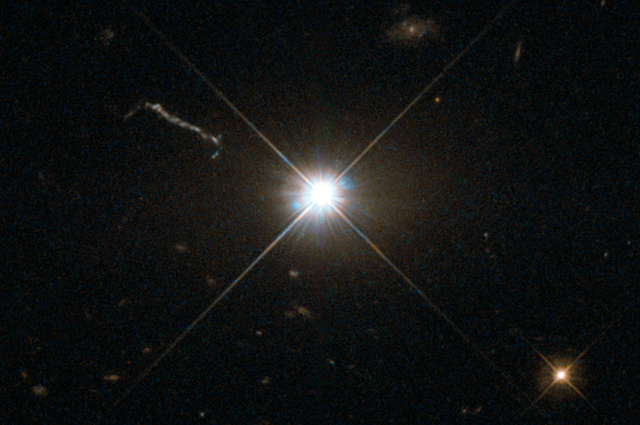Imagine staring directly into the brightest light you've ever seen and trying to spot the tiniest detail around it. That's the challenge astronomers face when studying quasars, those incredibly powerful and luminous objects found at the centers of galaxies. These cosmic engines, fueled by supermassive black holes attaching up nearby matter, shine with a brilliance that can outshine entire galaxies. Recently, scientists achieved a remarkable feat as they examined deeper into the heart of one of the most famous quasars, 3C 273, than ever before, thanks to NASA's Hubble Space Telescope.
A Historic Glimpse into 3C 273
3C 273, located at a staggering 2.5 billion light-years away which was first discovered in 1963. For decades, it has served as a crucial tool for scientists seeking to understand the complex relationship between black holes and their host galaxies. This quasar has helped us uncover how these massive black holes grow and influence their surroundings. Now, using the powerful Space Telescope Imaging Spectrograph (STIS) aboard Hubble, researchers have achieved an unprecedented level of clarity in their observations.
Overcoming the Glare: A Technological Triumph
The difficulty in studying a quasar like 3C 273 lies in its overwhelming brightness. Think of it as trying to see an ant on a car headlight—the glare simply hides the complicated details. To overcome this, the Hubble team employed STIS, which acts like a coronagraph. This clever device blocks out the central light source, much like the Moon blocks the Sun during a solar eclipse. By effectively dimming the quasar's blinding core, astronomers were able to reveal the environment surrounding the black hole with remarkable precision.
A Surprising Discovery: Cosmic Blobs and a Mysterious Filament
What the scientists discovered was truly surprising. "We've got a few blobs of different sizes and a mysterious L-shaped filamentary structure," explained Bin Ren of the Côte d'Azur Observatory and Université Côte d'Azur in France. "This is all within 16,000 light-years of the black hole." These features are not just random cosmic debris. Instead, they could represent small satellite galaxies being drawn into 3C 273, providing fuel for the supermassive black hole at its center. This process of feeding the black hole is what powers the quasar's immense energy output.
A New Gateway to Understanding Quasars
Ren further emphasized the significance of this achievement: "Thanks to Hubble's observing power, we're opening a new gateway into understanding quasars. My colleagues are excited because they've never seen this much detail before." This breakthrough provides an unparalleled opportunity to study the dynamics of quasars and the intricate interplay between black holes and their galactic environments. By revealing the fine details around these cosmic powerhouses, scientists are gaining invaluable insights into the fundamental processes that shape our universe.
Quasars: Ancient Beacons Lighting Up the Universe
Around 3 billion years after the Big Bang, the universe looked very different from how it does today. Galaxies were still forming and often crashing into each other in massive cosmic collisions. These galaxy mergers played a major role in creating something extraordinary—quasars. When two galaxies collided, they then pushed enormous amounts of gas and dust toward the centers of their galaxies. Many galaxies have supermassive black holes at their cores, and these swirling materials would fall into them. This process didn’t just disappear quietly—it created some of the brightest objects in the universe.
What Exactly Is a Quasar?
A quasar (short for "quasi-stellar radio source") is a very powerful and energetic object powered by a supermassive black hole. Even though black holes themselves do not emit light, the matter spiraling into them gets extremely hot due to friction and gravitational forces. This hot material glows brilliantly and gives off energy across many forms of light—radio waves, visible light, ultraviolet rays, and even X-rays. This makes quasars incredibly bright, even though they are located billions of light-years away. Some quasars shine with more light than all the stars in the largest galaxies combined. In fact, one of the most famous quasars, 3C 273, is over ten times brighter than the biggest known galaxies. It’s so luminous that, if it were only a few dozen light-years from Earth, it would shine as brightly as the Sun in our sky.
How Quasars Get Their Energy?
The reason quasars shine so brightly is all about the material falling into the black hole. As gas and dust move closer to the black hole, they form what’s called an accretion disk—a swirling, flat circle of matter. As this matter spirals inward, it gets compressed and heats up to extreme temperatures. That heat causes the matter to glow and emit energy across the entire electromagnetic spectrum. This is why quasars are considered some of the most luminous objects in the universe. The energy they give off comes not from the black hole itself but from the superheated material falling into it.
Why Quasars Matter?
Quasars aren't just interesting because they're bright—they also help scientists understand what the early universe was like. Since quasars were more common billions of years ago, studying them allows astronomers to look back in time and learn about the early stages of galaxy formation. They are like time capsules, giving us a glimpse into how chaotic and energetic the young universe really was.
Hubble’s remarkable imaging also revealed a new feature—a massive jet of material emanating from the black hole. This jet, stretching an extraordinary 300,000 light-years into space, is propelled at speeds nearing that of light itself. Jets of this scale represent some of the most extreme occurrences in the cosmos and continue to fascinate astronomers. By comparing newly acquired coronagraphic data with Hubble images taken 22 years earlier, scientists were able to track this jet’s motion over time. Interestingly, they noticed that certain parts of the jet appeared to accelerate as they moved farther away from the black hole. This peculiar observation has sparked further inquiry, as it may reveal how the jet interacts with its surrounding galaxy and the vast areas of intergalactic space.
. . .
References:

